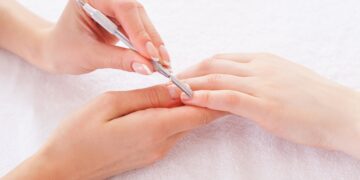Understanding Cuticles and Their Importance
When it comes to nail care, understanding the anatomy of the nail is crucial. The term ‘cuticle’ is often misunderstood, leading to improper nail care techniques. The cuticle is the thin layer of dead tissue found between the eponychium and the nail plate. Its primary function is to form a protective seal against dirt and debris, thereby protecting the nail matrix.
The eponychium is often mistaken for the cuticle and is the living skin bordering the base of the nail plate. This part should not be pushed back or cut to avoid infection and injury.
Why Proper Cuticle Care Matters
Proper care of the cuticle is essential not only for aesthetic reasons but also to prevent infections and ensure the health of the nail plate. Neglecting the cuticle can lead to infections like paronychia and compromised nail integrity.
Step-by-Step Guide to Properly Remove a Cuticle
Step 1: Prep the Nails
Begin by removing any polish or nail products. Apply a suitable cuticle remover and soak the hands in warm water mixed with a soak, which softens the skin and cuticles. After a few minutes, thoroughly dry the hands with a clean towel.
Step 2: Choose Your Tool
Opt for a metal cuticle pusher with a spoon shape or an orangewood stick if metal tools aren’t allowed. Both tools are effective; however, the orangewood stick is especially versatile across varied regulations.
Step 3: Push and Expose the Cuticle
Hold your tool as you would a pencil. Apply gentle pressure against the eponychium to reveal the cuticle. Refrain from pushing too forcefully to avoid injury.
Step 4: Remove the Non-Living Tissue
With the cuticle exposed, carefully remove it from the nail plate using a curette or scraper blade. Avoid using nippers to pull or tug at the cuticle, as this can damage the nail plate and lead to infections.
In Case of Accidents
Despite best efforts, accidents happen. If a cut occurs: immediately stop the service, have the client wash their hands, cover the cut, and follow your disinfection protocol. It’s critical to never continue working on an open wound, prioritizing cleanliness and client health above all else.
Cuticle Remover: Pros and Cons
Cuticle removers facilitate easier and safer removal, using compounds like potassium or sodium hydroxide to soften dead tissue. However, they can also soften the nail plate, leading to complications if misused. Always consult the client for allergies and conduct a spot test if unsure.
Expert Opinions
Thanks to Doug Schoon, CND Chief Scientific Advisor, and insights from ‘Cosmetic Dermatology Products & Procedures’, we have robust knowledge on nail care. The proper understanding and treatment of cuticles can safeguard not only nail health but also client trust and satisfaction.
Use this guide to enhance your nail practices, ensuring well-maintained cuticles and healthy, beautiful nails for your clients.

























